
Beetles are insects that form the order Coleoptera, in the superorder Endopterygota. Their front pair of wings are hardened into wing-cases, elytra, distinguishing them from most other insects. The Coleoptera, with about 400,000 described species, is the largest of all orders, constituting almost 40% of described insects and 25% of all known animal species; new species are discovered frequently, with estimates suggesting that there are between 0.9 and 2.1 million total species. Found in almost every habitat except the sea and the polar regions, they interact with their ecosystems in several ways: beetles often feed on plants and fungi, break down animal and plant debris, and eat other invertebrates. Some species are serious agricultural pests, such as the Colorado potato beetle, while others such as Coccinellidae eat aphids, scale insects, thrips, and other plant-sucking insects that damage crops.
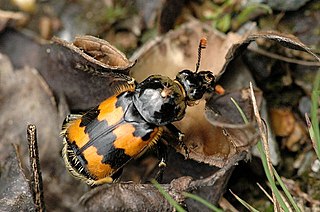
Silphidae is a family of beetles that are known commonly as large carrion beetles, carrion beetles or burying beetles. There are two subfamilies: Silphinae and Nicrophorinae. Nicrophorines are sometimes known as sexton beetles. The number of species is relatively small at around two hundred. They are more diverse in the temperate region although a few tropical endemics are known. Both subfamilies feed on decaying organic matter such as dead animals. The subfamilies differ in which uses parental care and which types of carcasses they prefer. Silphidae are considered to be of importance to forensic entomologists because when they are found on a decaying body they are used to help estimate a post-mortem interval.

The Japanese beetle is a species of scarab beetle. The adult measures 15 mm (0.6 in) in length and 10 mm (0.4 in) in width, has iridescent copper-colored elytra and a green thorax and head. It is not very destructive in Japan, but in North America and some regions of Europe is a noted pest to roughly 300 species of plants, including rose bushes, grapes, hops, canna, crape myrtles, birch trees, linden trees, and others.

The raspberry is the edible fruit of a multitude of plant species in the genus Rubus of the rose family, most of which are in the subgenus Idaeobatus. The name also applies to these plants themselves. Raspberries are perennial with woody stems. World production of raspberries in 2020 was 895,771 tonnes, led by Russia with 20% of the total.

Dung beetles are beetles that feed on feces. Some species of dung beetles can bury dung 250 times their own mass in one night.
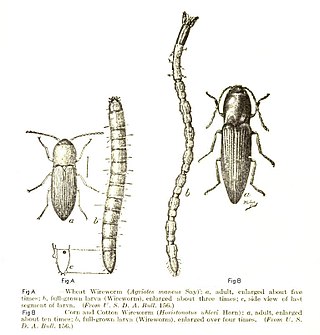
Elateridae or click beetles are a family of beetles. Other names include elaters, snapping beetles, spring beetles or skipjacks. This family was defined by William Elford Leach (1790–1836) in 1815. They are a cosmopolitan beetle family characterized by the unusual click mechanism they possess. There are a few other families of Elateroidea in which a few members have the same mechanism, but most elaterid subfamilies can click. A spine on the prosternum can be snapped into a corresponding notch on the mesosternum, producing a violent "click" that can bounce the beetle into the air. Clicking is mainly used to avoid predation, although it is also useful when the beetle is on its back and needs to right itself. There are about 9300 known species worldwide, and 965 valid species in North America.

Pest control is the regulation or management of a species defined as a pest; any animal, plant or fungus that impacts adversely on human activities or environment. The human response depends on the importance of the damage done and will range from tolerance, through deterrence and management, to attempts to completely eradicate the pest. Pest control measures may be performed as part of an integrated pest management strategy.

Trogidae, sometimes called hide beetles, is a family of beetles with a distinctive warty or bumpy appearance. Found worldwide, the family includes about 300 species contained in four or five genera.

The blue spruce, also commonly known as green spruce, Colorado spruce, or Colorado blue spruce, is a species of spruce tree. It is native to North America, and is found in USDA growing zones 1 through 7. It is found naturally in Arizona, Colorado, Idaho, New Mexico, Utah and Wyoming. It has been widely introduced elsewhere and is used as an ornamental tree in many places far beyond its native range. The blue spruce has blue-green colored needles and is a coniferous tree.

Lactarius deterrimus, also known as false saffron milkcap or orange milkcap, is a species of fungus in the family Russulaceae. The fungus produces medium-sized fruit bodies (mushrooms) with orangish caps up to 12 centimetres wide that develop green spots in old age or if injured. Its orange-coloured latex stains maroon within 30 minutes. Lactarius deterrimus is a mycorrhizal fungus that associates with Norway spruce and bearberry. The species is distributed in Europe, but has also found in parts of Asia. A visually similar species in the United States and Mexico is not closely related to the European species. Fruit bodies appear between late June and November, usually in spruce forests. Although the fungus is edible—like all Lactarius mushrooms from the section Deliciosi—its taste is often bitter, and it is not highly valued. The fruit bodies are used as source of food for the larvae of several insect species. Lactarius deterrimus can be distinguished from similar Lactarius species by difference in the mycorrhizal host or latex colour.

Cleridae are a family of beetles of the superfamily Cleroidea. They are commonly known as checkered beetles. The family Cleridae has a worldwide distribution, and a variety of habitats and feeding preferences.

Bursaria spinosa is a small tree or shrub in the family Pittosporaceae. The species occurs mainly in the eastern and southern half of Australia and not in Western Australia and the Northern Territory. Reaching 10 m (35 ft) high, it bears fragrant white flowers at any time of year but particularly in summer. A common understorey shrub of eucalyptus woodland, it colonises disturbed areas and fallow farmland. It is an important food plant for several species of butterflies and moths, particularly those of the genus Paralucia, and native bees.
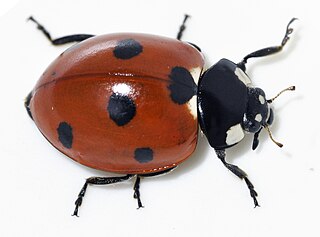
Coccinellidae is a widespread family of small beetles. They are commonly known as ladybugs in North America and ladybirds in Great Britain. Entomologists prefer the names ladybird beetles or lady beetles to avoid confusion with true bugs. Many of the species have conspicuous aposematic colours and patterns, such as red with black spots, that warn potential predators that they are distasteful.

An earthworm is a terrestrial invertebrate that belongs to the phylum Annelida. They exhibit a tube-within-a-tube body plan; they are externally segmented with corresponding internal segmentation; and they usually have setae on all segments. They occur worldwide where soil, water, and temperature allow.

Cyclocephala borealis, the northern masked chafer, is a beetle in the family Scarabaeidae. It is native to North America, where it is considered a crop pest.
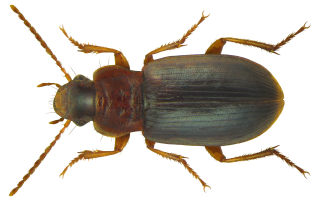
Ophonus rufibarbis is a species of ground beetle that can be found everywhere in Europe and the Near East.

Hypomeces pulviger, also known as the gold-dust weevil or green weevil, is a species of beetle in the true weevil family. The adult weevil can reach a length of about 14 mm (0.6 in) and is covered with iridescent green or yellowish-green dust-like scales all over the body. This species can be found in India, tropical Southeast Asia, and the Philippines. Both the larvae and adults are crop pests. The larvae live in and pupate in the soil, feeding on living plant roots. The adult weevils are long-lived, doing damage to foliage, and sometimes defoliating young bushes and nursery trees.
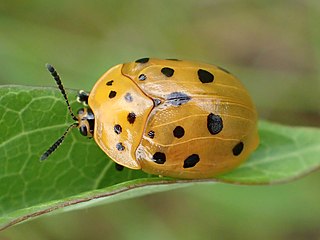
Chelymorpha cassidea, known generally as the Argus tortoise beetle or milkweed tortoise beetle, is a species of leaf beetle in the family Chrysomelidae. It is found in the Caribbean and North America.

Myosotis secunda, also known as the creeping forget-me-not is a species of flowering plant from the family Boraginaceae.


















